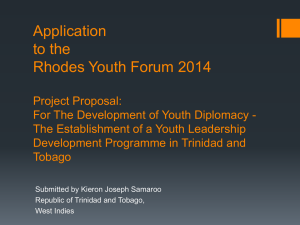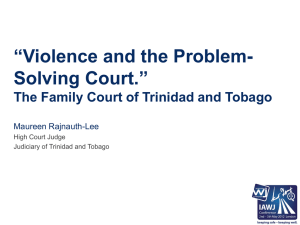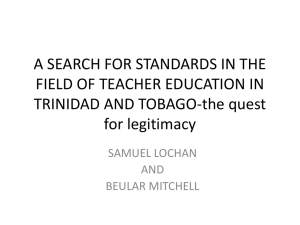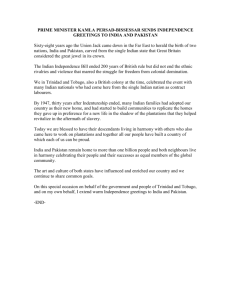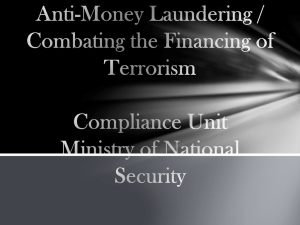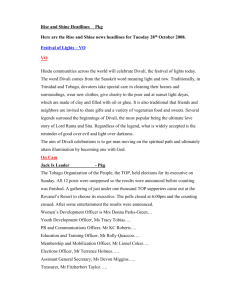Tobago, West Indies Questions & Answers September 2011 Table of
advertisement
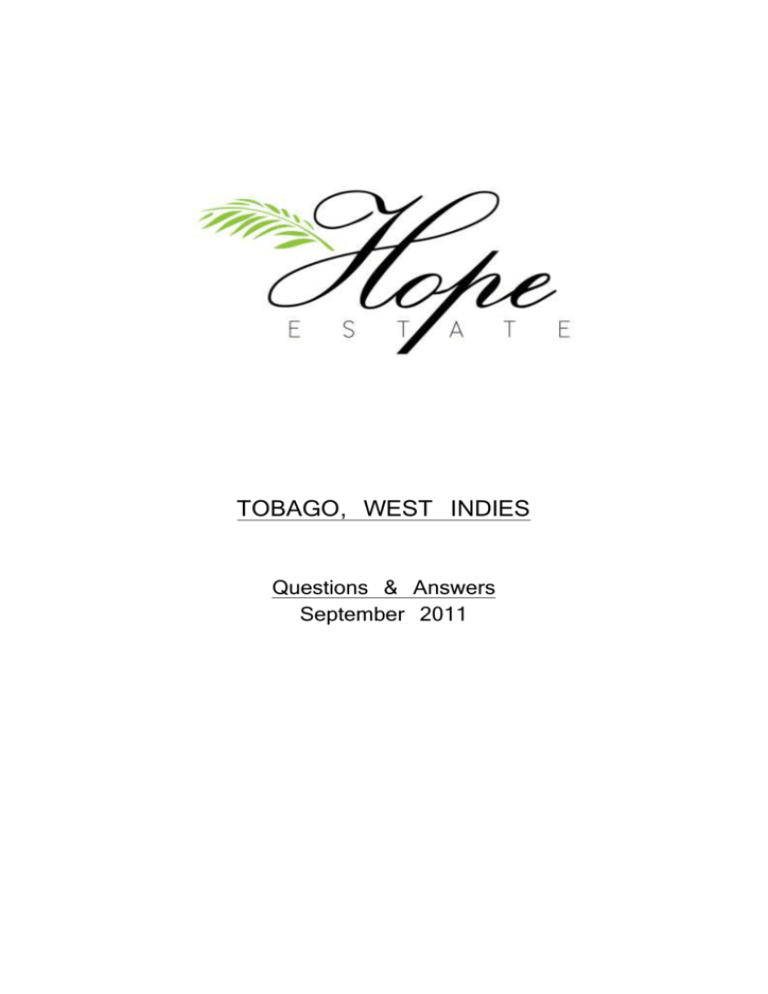
TOBAGO, WEST INDIES Questions & Answers September 2011 Table of Contents Section 1 - The Development Page 3 Section 2 - Development Financing Page 6 Section 3 – Payment Options Page 7 Section 1 - The Development What is the history of Hope Estate? Throughout the 1950s, the majority of the lands of Hope Estate were utilised primarily as a large coconut plantation of approximately 607ha (1,500acres) in area. Hope Estate also accommodated a longstanding residential/resort development that thrived on the picturesque breezy plateaus that overlooked Hillborough Bay. The majority of Hope Estate was sold to the State, save a 19.56ha parcel, which has been retained by the family of the original owner, Mr. John Daly. The development existed on two parcels prior to 1963 and proudly included: The Greensands Cottages Hotel The Estate House Agricultural Land A community of residences Beach and bath house The family has now made a decision to restore the historical heritage of the lands by reverting to the original land usage. Who are the Developers? Sebastien Paddington B.Sc., M.U.P., P.M.C.I.P, M.T.T.S.P.: Mr. Paddington heads International Project Initiatives Limited (IPI Ltd.) which acts on behalf of the landowners of Hope Estate (Hope Bay Limited and Tobago Land Holdings Limited) and is the development company responsible for the development of the Hope Estate Integrated Development. Mr. Paddington is Vice President of GENIVAR TT, which is a Caribbean leader in architecture, engineering and project management, delivering local solutions based on a global approach to projects. He is also a former vice-president of the Trinidad and Tobago Society of Planners. He advocates the integrated development of land and supporting networks, which are aesthetically pleasing and promote human wellbeing and environmental harmony. With over ten years of experience in the development of land and buildings, Mr. Paddington has been involved in a large variety of projects producing innovative technical, sociological and economic mechanisms for integrated land use planning and layout designs in Canada, the U.S.A. and the Caribbean. Colin Laird CMG, Hon FAIA, RIBA, Dip Arch, FTTIA: Mr. Laird provides core architectual support to the project. With over sixty years of experience in the field of architecture, urban design and planning, he is regarded as one of Trinidad and Tobago’s foremost contemporary architects and has been listed as one of the top 300 architects in the world. Mr. Laird is an Honorary Fellow American Institute of Architects, a Fellow Trinidad and Tobago Institute of Architects and was recently awarded the Chaconia Gold Medal by the Government of the Republic of Trinidad and Tobago for outstanding service to the country. William Agard DLc, Bsc, F.A.P.E., Reg Eng.: Mr. Agard provides core engineering support to the project. Mr. Agard graduated from Loughborough University in 1960 as a Civil Engineer and worked with Howard Humphrey’s and Sons -Consulting Engineers, UK until 1968. He joined David Key and Partners in 1968 (Later CEP Ltd) and retired as the Senior Partner from CEP Ltd in 1999. He is a registered Engineer with the Board of Engineering and a Fellow of the Association of Professional Engineers of T&T (F.A.P.E.). GSAL Designs Limited: GSAL Designs Ltd. provides core architectural support to the project. Founded in 2006 by its principal Gregory Salandy, GSAL Designs Ltd. has become one of the top architecture firms based in Trinidad and Tobago’s capital city of Port of Spain. They offer professional services in commercial, residential, governmental, institutional, tourism related architecture, landscape architecture, urban planning and urban design. Talma Mill Studios: Talma Mill Studios provides core landscape architectural support to the project. Talma Mill Studios is a leading Caribbean landscape architectural firm. Since 1991 the firm has been at the forefront of developing Caribbean landscape architecture with a global relevance. The firm has experience in all aspects of Landscape Design, Urban Design, Environmental, Development and Tourism Planning. The goal of the studio is to make a positive impact on the built and natural environment and contribute to their client’s success and happiness. J.B. Kelshall & Co.: J.B. Kelshall & Co. provides core legal support to the project. J. B. Kelshall & Co. is one of Trinidad and Tobago’s leading legal firms. Mr. Lee Kelshall is the principal lawyer and offers a wide range of legal expertise and advice related to land and building developments, with extensive experience in Tobago. It should be noted that J.B. Kelshall & Co have had a long standing relationship with Hope Estate dating back to the 1950s when Mr. Lee Kelshall’s father was the company’s principal lawyer, thereby providing Lee Kelshall with a comprehensive understanding of the past, present and future of Hope Estate. What experience does the development team have with this type of project? Mr. Paddington has overseen the Planning and Project Management of some of the most significant multi-million dollar projects in the recent history of Trinidad and Tobago and many which have permanently changed the landscape of its major cities. He has played key roles as Senior Land Use Planner and Project Manager for the Development of Draft Spatial Plans for Princes Town, Penal/Debe, the Urban Master Plan Revitalization of Scarborough, the Port of Port of Spain Redevelopment Project and the Urban Master Plan Revitalization of Central Port of Spain. Mr. Laird has over 60 years experience in Trinidad and Tobago and the wider Caribbean. Some of his past projects in Trinidad and Tobago include Queens Hall, the Hasely Crawford Stadium and Jean Pierre Complex, the Brian Lara Promenade and the National Library. Mr. Agard has been designing and supervising civil works in Trinidad and Tobago, Grenada, Barbados and Dominica for several years. These large infrastructural projects include road, drainage and sewerage works designed for the Mt Irvine and Bacolet Developments in Tobago, the Fort Jeudy Developments in Grenada and the Pax Vale and El Guamal Developments in Santa Cruz and the Darwill Developments, in Arima, Trinidad and Tobago. Where is the company/companies registered? The Republic of Trinidad and Tobago Who are the main shareholders? Hope Bay Limited and Tobago Land Holdings Limited are the main shareholders. Each company owns 50% of the estate. How large is the entire development? 50 acres How many parcels are for sale? The entire Hope Estate Integrated Development consists of 111 lots. Phase I of the development has placed 46 lots for sale on the market with the remaining lots to be sold in subsequent phases. What state approvals have been obtained for the dissection and sale of the property? All approvals have been obtained inclusive of T&CPD, WASA, Drainage, Health and EMA. Is the land considered leasehold or freehold? The land is being sold as leasehold under a 999-year lease. What is the permitted use of the land? Every Property Owner is responsible for the development of one single-family dwelling the residence, on each lot and/or Parcel in his possession. (Multiple family dwellings will be permitted under special circumstances and conditions). Will pets be allowed in the development? A limited number of selected domestic pets and animals may be kept on individual properties for the noncommercial use of the Property Owner. Are there are any height restriction in terms of building on the land? The building covenants restrict the building heights of all houses to a maximum of two storeys (approx 8.5m). Does construction have to commence within a certain time period? No, you are free to build at your own pace. Does the developer have any recommended housing designs and an existing architect that I can work with? Yes, the main architect for the project, Mr. Gregory Salandy has prepared several options of housing design that can be utlised by the buyers. What is the time frame for the development? The project will commence in the dry season of 2012 and completion will be 8 months thereafter (before the end of 2012). What will the infrastructure consist of? Gated Community with privacy and security Landscaped green spaces for active and passive recreational purposes Beach access and facilities including restaurant and bar, showers and benches. A communal multi-purpose centre, inclusive of gym facilities, meeting rooms, and restaurant and bar (linked to the beach restaurant and bar) Underground utilities Does the development have access to a beach and what is it like? The development sits adjacent to the Hope Beach, which is over a mile long. Hope Estate owns this beach from the high water mark to the edge of the road reserve. All beaches in Tobago require public access. There are comprehensive plans to upgrade the beach facilities inclusive of regular cleaning, landscaping and construction of an eco-friendly beach bar/grill, benches, showers, etc. A feasibility exercise is also being undertaken to ascertain the possibility of constructing shore protection features in the near future for additional shelter for boat anchorage, snorkelers, swimmers, etc. Will there be an owners association and how will this be set up? Yes. These details can be found within the Deed of Lease, which is available on the Hope Estate website. Will there be rental opportunities and will this be managed centrally? Yes there will be a property management company established for Hope Estate. Section 2 - Development Financing How is the project being financed? All project costs to date i.e. detailed designs, statutory approvals, tendering, road cutting and clearing, lots clearing, surveys, maintenance, advertising, professional fees (accounting, legal, project management), etc, have been borne by developers. The sale of pre-developed lots will provide the additional cash input necessary to finance the completion of all infrastructural works required for obtaining a completion certificate. Several banks (RBL/Scotia/RBC), however, have offered financing should it be required. How will the contractor be paid? The contractor will only be paid upon full delivery and careful inspection and certification by the project team. Section 3 – Payment Options & Costs What are the various payment options? There are 4 main payment options with varying associated degrees of discount. These are as follows: Option 1 - 10% off the sales price: 10% due on signing of Commitment Letter, 15% due on signing of the Sale Agreement and the balance of 75% of the purchase price payable due in 90 days. Option 2 - 7.5% off the sales price: 10% due on signing of Commitment Letter, 15% due on signing of the Sale Agreement, 72.5% due 90 days from the date of the Agreement and the balance of 2.5% of the purchase price payable on the Vendor obtaining the completion certificate from the Local Health Authority Option 3 - 5% off the price: The original terms of payment as per the Sale Agreement, 10% due on signing of Commitment Letter, 30% due on signing of the Sale Agreement, 25% due after completion of basic earthworks, 25% due after all infrastructure and utilities are completed and the management certificate presented and the balance of 10% of the purchase price payable on the Vendor obtaining the completion certificate from the Local Health Authority Option 4 - no discount: 10% due on signing of Commitment Letter, 15% due on signing of the Sale Agreement and the balance of 75% of the purchase price payable once the completion certificate is given to the purchaser Is the down payment held in escrow and how is it released? Deposits paid are held in escrow until the number of lots required to be sold to guarantee completion of the project are sold. Once this is achieved the contractor will then immediately mobilize under the direction of Mr. Bill Agard (Project Engineer) and the prospective purchasers will concurrently sign the Sale Agreement with Mr. Lee Kelshall (Project Lawyer). The 10% deposit is then released from escrow and the additional 15% is paid. Thereafter, all subsequent payments depend on the purchase option chosen. What are the expected closing costs? Upon the decision to purchase a home site, a lawyer must be hired to convey the property and to do the necessary searches for the property in order to ensure that the property is being sold free of all encumbrances and with vacant possession. An Example of Conveyance Charges & Costs are as follows: Legal Fees (TT$4,5000-TT$7,000) Search Fees (TT$1,000.00) Registration Fee (VAT exempt) (TT$100.00) Oath/Copies (TT$150.00) Valuation (on a dwelling) (1/2 of 1% of property value) Stamp Duty VAT (15%) is charged on all expenses with the exception of the Registration Fee, the Stamp Duty and the Search Fee Stamp Duty on Residential Land (Land Only) The consideration must be greater than TT$450,000.00 and is calculated as follows: When the purchase price is below TT$450,000.00 - 0% Between TT$450,001.00 and TT$650,000.00 - 2% on every dollar in excess of TT$450,000.00 Between TT$650,001 and TT$850,000.00 - 5% on every dollar in excess of TT$650,000.00 When the purchase price is over TT$850,000.00 - 7% on every dollar in excess of TT$850,000.00 Can non-Trinidad and Tobago resident purchase property in Tobago? Foreigners are allowed to purchase property in Tobago but they must apply for a license before doing so. Application guidelines and an Application form can be found on the Trinidad & Tobago Ministry of Finance website: www.finance.gov.tt (Application guidelines: www.finance.gov.ttdocuments/news/mrEC0CBD.pdf and Application form: www.finance.gov.tt/documents/129.pdf) Are the various contracts available for viewing? Yes, all the legal contracts are available for viewing as well as download on the Hope Estate website which can be found at www.hopeestatetobago.com.
